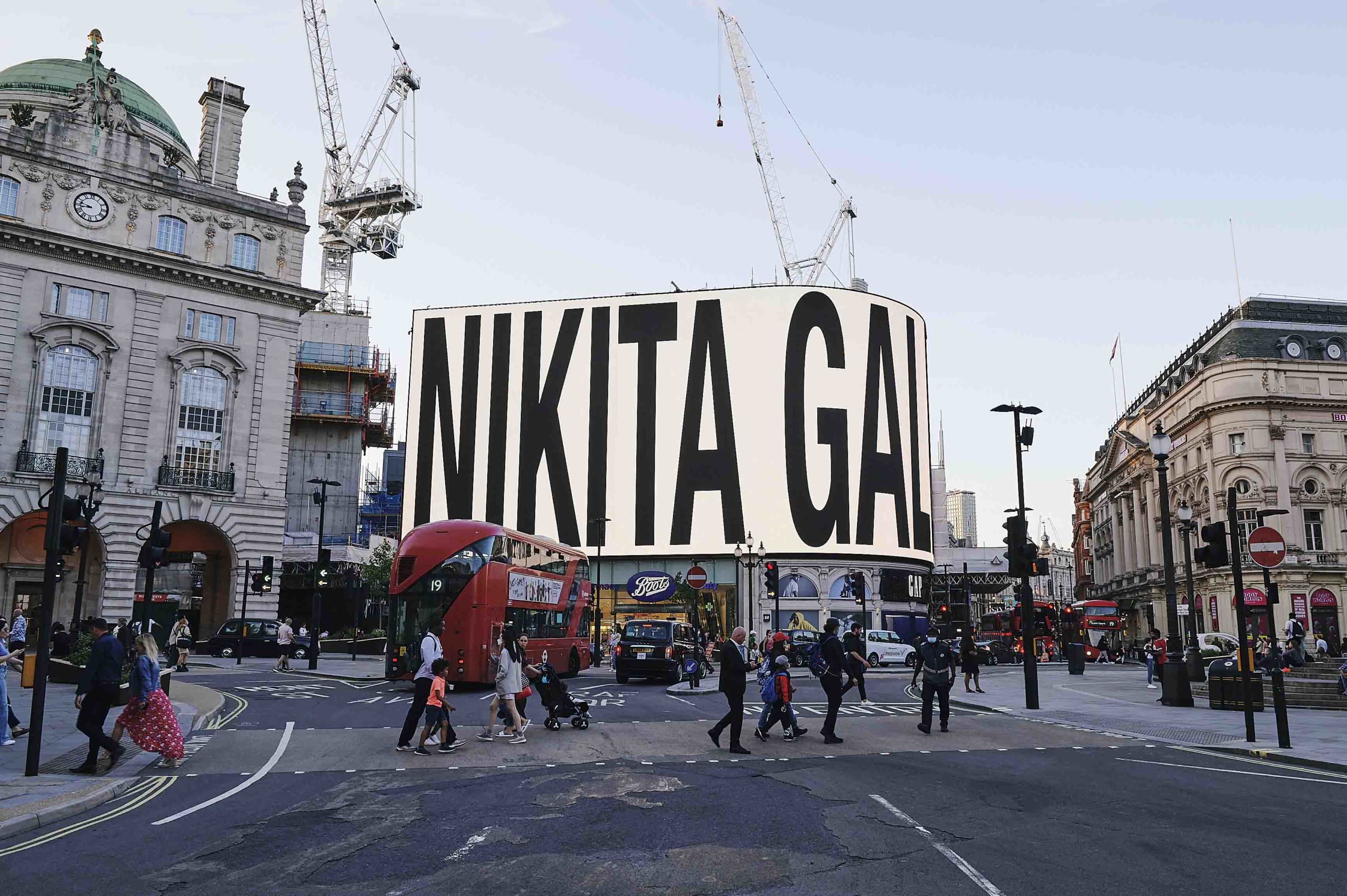Zoé Whitley In Conversation With Nikita Gale

Curated this month in collaboration with Chisenhale Gallery, London, directed by Zoé Whitley, Nikita Gale’s new series of films for CIRCA titled ‘SOME WEATHER’ spotlight the creative labour of Black women whose voices feature in some of rock music’s most acclaimed recordings, from the Rolling Stones to David Bowie.
Four films titled ‘Heat’, ‘Fog’, ‘Blizzard’, and ‘Rain’ will feature on the CIRCA platform throughout June 2021, appearing daily with the unpredictability of weather patterns. Each film takes on a different radiant hue, employing the immensity of these cities’ advertising screens to shift the atmosphere of their respective urban settings.
Zoé Whitley: Before we’d met, I’d already encountered your writings about listening as a political act. Drawing on the research of Prof Kate Lacey, you’ve focused on how the freedom to listen is not just about freedom of speech, but is fundamental to ensuring many voices are heard. How did sound come to play such an important role for you as a visual artist?
Nikita Gale: It’s nice to know that the research and writing is finding its way around. It’s always a bit difficult to track how things are resonating with others since digital interactions often feel like projecting into a void. My interest in sound emerged from a more specific interest and exposure to music from an early age. My mother was a music teacher when I was growing up, so there was always a piano in the house; there was always music playing from whatever the most recent stereo system was that my father had brought into the house. My father began his military career as a civil engineer in the Air Force, so there were always little models and drawings of buildings and bridges and other kinds of infrastructures floating around the house. As I entered high school and college, I began recording my own music, mostly very loopy electric guitar compositions that became much more pop-y after college. I was a bedroom musician. I never performed but I had a small following on Myspace and got a little radio play in the mid-00s, haha. After college, I started working in advertising in the buying and planning side, so my job was essentially to make sense of behavioral data and find ways to make that data profitable. So I was working in advertising by day, and started shooting music shows at night, literally. At this point, I was living in Atlanta and was photographing a lot of my friends who were musicians, shooting album covers, press photos; I’d also started a music blog where I’d review singles I was really into. I eventually began experimenting with other mediums but sound always found a way into whatever I was doing.

In graduate school at UCLA, I had gotten really into cars and was thinking about cars as objects that do a lot of work as psychological objects — culturally we project a lot into them. From the car work, I came across some very interesting details about how guitar designers in the 50s and 60s — the time at which rock and roll was emerging as a genre — were hiring car designers to design their electric guitars, even going so far as to use the exact same paint on guitar bodies and car bodies. These developments in rock and roll were also fascinating to me because I was thinking about how music was (and still is) one of the only spaces in which Black people in America could openly express desire and dissent albeit in very coded language, and not only express desire or dissent but broadcast it by way of radio. I doing most of this research in 2016, shortly after finishing graduate school and at the beginning of the Trump presidency. I was feeling fairly cynical and despondent, and one of the only things that helped me maintain some faint sense of optimism or belief in the power of art to do anything was PJ Harvey’s album “The Hope Six Demolition Project.” It inspired me to make the work BIG BAD PICKUP, which was a noise sculpture. I was really feeling the urge to be very loud while also wanting to totally disappear or be protected in some way. I was feeling very unsafe in public space, physical or digital, it didn’t really matter. So there was the idea of navigating between silence and noise. But there was also the way in which Trump had managed to weaponise speech and dissent; it was so familiar and yet really horrifying to experience it in real time. This was around the time that I began thinking more specifically about the ways in which material conditions directly impact how audiences are formed and how speech and sound can be manipulated, amplified, and silenced.
The work I began with Triple Canopy in 2018, Omniaudience is also a very important part of this work around sound as well.
ZW: Is there a distinction for you around the ways we listen to music and the ways we listen to other forms of spoken communication or non-verbal sounds? I’m thinking about background noise — how technologies like white noise and guided meditation apps are designed to help us switch off. What role does ambient sound play in your work, for instance in your approach to scoring SOME WEATHER?
NG: Absolutely. In the 1960s the composer and theorist R. Murray Schafer introduced the concept of the soundscape – a rudimentary organizational structure or tableau in which sounds could be understood as belonging to one of three categories: keynotes, soundmarks, and signals. I won’t get into the details here, but anyone who is curious can do more research around the terms. What I will say about this, is that the things that are legible as keynotes, soundmarks, and signals to one person can be read by another person in an entirely different way. What is sensed sonically is larged conditioned by one’s environment — environment encompasses not just physical environment but also gender, race, class, education, life experiences and so on. And in this way, sound is a deeply social arena in a very literal way. As much as I enjoy leaning into the metaphorical aspects of sound, there are some aspects of it that are actually very interesting without the abstraction of metaphor.
With the sound compositions for SOME WEATHER, I really tried to have fun with it and approach it somewhat intuitively. I used a variety of production methods, from ambient modular synthesis to straight up midi DAW digital instruments and effects.
ZW: Let’s talk about the weather. In Britain, weather is a perennial topic of conversation because it’s deemed to be uncontroversial. Safe ground upon which all walks of life can agree. Yet Oscar Wilde wrote,
“Pray don’t talk to me about the weather… Whenever people talk to me about the weather, I always feel quite certain that they mean something else. And that makes me quite nervous.”
In this work, you’re invoking Toni Morrison and Christina Sharpe’s writings, where weather certainly means more than it appears to be. Can you elaborate?

NG: Yes, well the thing that I find most compelling about the idea of weather is the sense that it operates at a scale that exceeds the ability of humans to control it, at least in an immediate sense. On the other hand, we now understand that climate change is very real and modern weather patterns and climate trends are being impacted by the cumulative effects of several centuries of human behavior and human-facilitated extraction and carbon emissions. In the same ways that cumulative behaviors have affected the literal atmosphere of the earth (and the Moon and Mars), these same cumulative behaviors have impacts on the sociopolitcal atmospheres. And this is what Christina Sharpe is pointing to in her use of the term of the weather. She speaks of weather as a social condition. For Sharpe, it is the total environment of anti-blackness that operates at every level of social life; it’s like air. Toni Morrison on the other hand, invokes weather as the shared space between bodies — it’s where we are constantly
exhaling and inhaling, creating the weather for one another is how I like to interpret it. I’ll share the specific passage from Beloved here for context: “By and by all trace is gone, and what is forgotten is not only the footprints but the water too and what it is down there. The rest is weather. Not the breath of the disremembered and unaccounted for, but wind in the eaves, or spring ice thawing too quickly. Just weather. Certainly no clamor for a kiss.”

ZW: Your first solo museum exhibition Private Dancer recently closed in Los Angeles, at CAAM (California African American Museum) 27 March – 9 May 2021. Often in your sculptures you conjure human presence in the absence of a perceptible figure. In SOME WEATHER, figures haunt the atmosphere without ever coming fully into view.
NG: Yes, I’m on a kick right now where I am really grappling with navigating between the conditions of visibility and recognition. This of course ties into my thinking around legibility and illegibility; how legibility is often a pre-condition for consumption; how these are all terms at play when thinking about performance and relationships between audiences and the objects of their attention. I was really excited about this CIRCA project because it presented an opportunity to create a scenario in which a series of unresolved, blurry or difficult to pindown figures haunt the screens, filling them with colors that simultaneously behave like flood lights that completely change the atmosphere of their surroundings. The images kind of force you to come to terms with the satisfaction that is often experienced by seeing a concise, resolved imaged. There’s a catharsis in consuming images when we think we understand them. This is an exciting experiment for me, for sure.